key AUDI A5 COUPE 2011 Workshop Manual
[x] Cancel search | Manufacturer: AUDI, Model Year: 2011, Model line: A5 COUPE, Model: AUDI A5 COUPE 2011Pages: 362, PDF Size: 84.88 MB
Page 171 of 362

___________________________________________________ H_o_ m_ e_L_ i_ n _ k_ ® __ _
Applies to vehicles : w ith Home link® un iversa l remote cont rol
Reprogramming a single button
A HomeLink ® button con be reprogrammed individually
without affecting the other button allocations .
Programming the overhead keypad
Press the appropriate Homelink® button until the indi
cator light begins flashing slowly.
At the radiator grille
1. Point the original remote control to the middle of the
radiator grille of your vehicle~
page 167, fig. 162.
2. Hold the original r emote control at a distance between O
S in . (0 -13 cm) (use the shortest distance poss ible) .
3 . Press and hold the activation button on the remote
control.
4. The emergency flashers will flash three times (after about
15-60 seconds) when the programming is successful.
Now release the button on the remote control.
- If the device utilizes a rolling code, please follow phase 3
of ~
page 167 , "Programming the Homelink® trans
mitter" for rolling code programming.
This procedure will cause the existing programming on the
Homelink ® button to be erased! •
Controls and equip
ment Safety first
App
lies to vehicles : w ith Home link® un iversa l remote cont rol
Erasing the programming of the
Homelink ® transmitter
When you erase the programming, the programming on
all three of the transmitter channels with be lost!
- Perform steps 1 to 4 as described on~ page 167, "Phase
1: programming the overhead keypad" .
When completed, the Homelink® system will b e in the programming
mode and is then ready to learn the codes for remote controlled
d evices.
[I] Tips
• Programm ed buttons canno t be e ras ed ind iv idually.
• For security reasons you are adv ised to erase the programming of
the Horne Link ® system befo re you sell your vehicle. •
Vehicle care Technical data
Page 186 of 362

___ s_a_ f_ e_ t_ y _ b_e _l_t _s ___________________________________________ _
Safety be lts attach passe ngers to t he car an d give th em the benef it of
b ei ng s lo we d d own mor e gentl y or "so ftly" throu gh th e "give" in the
sa fety bel ts, crush z ones a nd oth er safety feat ures engin eered in to
today 's vehicles . By "absor bing" the kinetic e ner gy over a lo ng er
p eriod of time, th e saf ety belts make the forces o n th e body mor e
"to lerable" and less likely to ca use inju ry .
Alt hou gh the se ex amp les a re based on a fr ontal col lis ion, safety bel ts
can a lso s ubstantially red uce the risk of in jur y in other ki nds of
cras hes. So , whe ther you 're o n a long tri p o r ju st go in g to th e co rner
sto re, a lways b uckle up a nd make sure others do, too. Accident statis
t ics s how t hat vehi cle occupan ts properly wea rin g safety belts have a
lower risk of bei ng in jured and a muc h better cha nce of s urvivi ng an
acc ident. Properly usi ng safety belts also greatly increases the ability
of the supp lemental a irbags to do t heir job in a co llisio n. For this
reason, wea ring a safety belt is lega lly re quir ed in most countries
including muc h of th e Uni ted Stat es and Canad a.
Altho ugh your Audi is equipped with a irbags, yo u still have to wear
t he s afety bel ts provi ded. Fr ont airba gs, for ex ample, are activ ated
only in some fro nta l collisions . T he front a irbags are not activated in
all fr ont al collis ions, in side and re ar co llisions, in ro ll overs or in cases
w her e th er e is no t enough d ecelerat io n t hroug h im pac t to th e fron t
o f th e ve hicle. T he same goes for the ot he r air bag sys tems in yo ur
Audi. So, always wear your saf ety be lt and make sure eve rybody in
your vehicle is properly restrai ned! •
Important safety instructions about safety
belts
S afety bel ts m ust alw ays b e co rre ctly po sitio ned a cross
t he str ongest bones o f your bo dy.
- Al ways we ar saf ety be lts as illustra te d an d descri bed i n
this c hapter.
- M ake sure that your s afet y be lts are alw ays re a dy f or use
a nd a re n ot d amaged .
& WARNING
Not wearing safety belts or wearing them improperly increases
the risk of serious personal injury and death. Safety belts can work only when used correctly.
• Always fasten your safety belts correctly before driving off and
make sure all passengers are correctly restrained.
• For maximum protection , safety belts must always be posi
tioned properly on the body.
• Never strap more than one person, including small children,
into any belt.
• Never place a safety belt over a child sitting on your lap.
• Always keep feet in the footwell in front of the seat while the
vehicle is being driven.
• Never let any person ride with their feet on the instrument
panel or sticking out the window or on the seat.
• Never remove a safety belt while the vehicle is moving. Doing
so will increase your risk of being injured or killed.
• Never wear belt s twisted .
• Never wear belts over rigid or breakable objects in or on your
clothing, such as eye glasses, pens, keys, etc., as these may cause
injury .
• Never allow safety belts to become damaged by being caught
in door or seat hardware.
• Do not wear the shoulder part of the belt under your arm or
otherwise out of position.
• Several layers of heavy clothing may interfere with correct
positioning of belts and reduce the overall effectiveness of the
system .
• Always keep belt buckles free of anything that may prevent the
buckle from latching securely . .._
Page 188 of 362
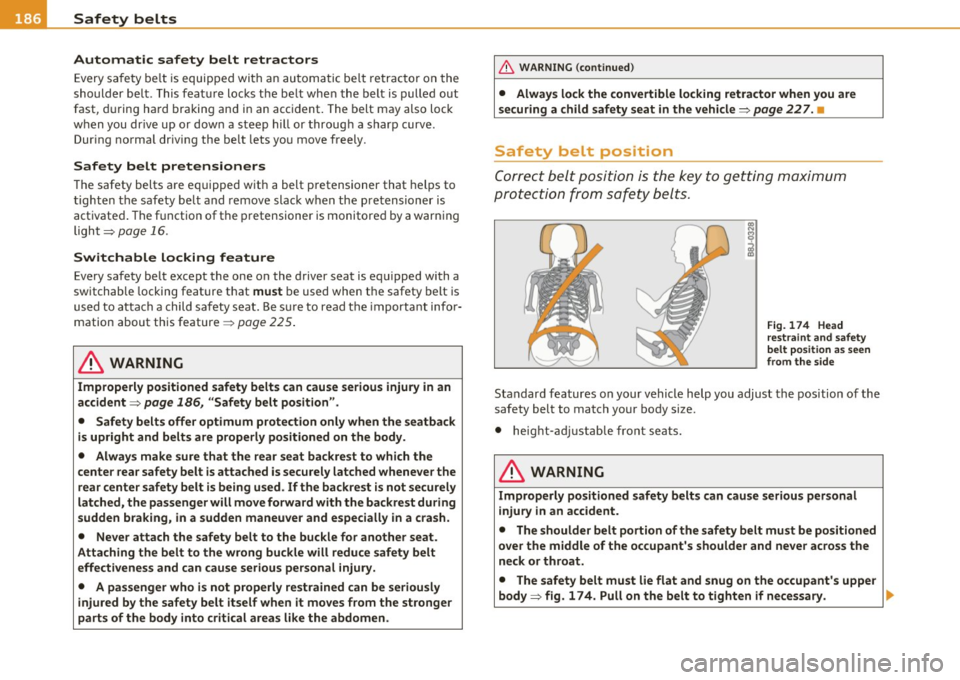
___ s_a_ f_ e_ t_ y _ b_e _l_t _s ___________________________________________ _
Automatic safety belt retractors
Every safe ty be lt is equipped with an automatic be lt retractor on the
shoulder belt . This feat ure locks t he be lt whe n the belt is pulled out
fast, d uring ha rd braking and in an accident. The belt may also lock
w hen you dr ive up or dow n a steep hill or throug h a sharp curve .
Dur ing norma l driv ing the belt lets you move freely.
Safety belt pretensioners
T he safety belts are eq uipped w ith a belt p retensioner that helps to
tighten the safety belt and remove slac k w hen the p retensioner is
activated . The f unction of the p retens ioner is monitored by a warn ing
light=>
page 16.
Switchable locking feature
E very safety be lt except the one on the driver seat is equipped with a
switchab le locking feature that
must be used when the safety belt is
used to attach a child safety seat. Be sur e to read t he importa nt info r
mation about this feature=>
page 225.
& WARNING
Improperly po sitioned safety belt s can cau se serious injury in an
accident =>
page 186, "Safety b elt position ".
• Safety belts offer optimum protection only when the seatback
is upright and belts are properly posit ioned on the body .
• Alway s make sure that the r ear seat backre st to which the
center rear safety belt is attached is se curely latched whene ver the
rear center safety belt is being u sed . If the ba ckre st is not securely
latched, the passenger will move forwa rd with the backrest during
sudden braking, in a sudden maneuve r and e specially in a crash.
• Never attach the safety belt to the buckle for another seat .
Attaching the belt to the wrong bu ckle will reduc e safety belt
effect iveness and can cause serious personal injury .
• A passenger who i s not properly restrained can be seriou sly
injured by the safety belt itself when it moves from the stronger
parts of the body into critical area s like the abdomen.
& WARNING (c on tinued )
• Alway s lock the convertible locking retractor when you are
securing a child safety seat in the vehicle=>
page 227. •
Safety belt position
Co rrect bel t posi tion is the key to get ting maximum
pro tec tion f rom safety belts .
Fig. 174 H ead
res traint a nd safety
belt po sit io n a s se en
from the side
Standard features on your vehicle help you adjust th e position of the
safety belt to match your body si ze.
• height-ad justable fron t sea ts.
& WARNING
Improperly po sitioned safety belts can cau se serious per sonal
i njury in an accident.
• The shoulder belt portion of the safety be lt must b e position ed
over the middle of the occupant's shoulder and never acro ss the
neck or throat.
• The safety belt must lie flat and snug on the occupant's upper
body => fig. 174. Pull on the belt to tighten if neces sary. .,,,.
Page 246 of 362
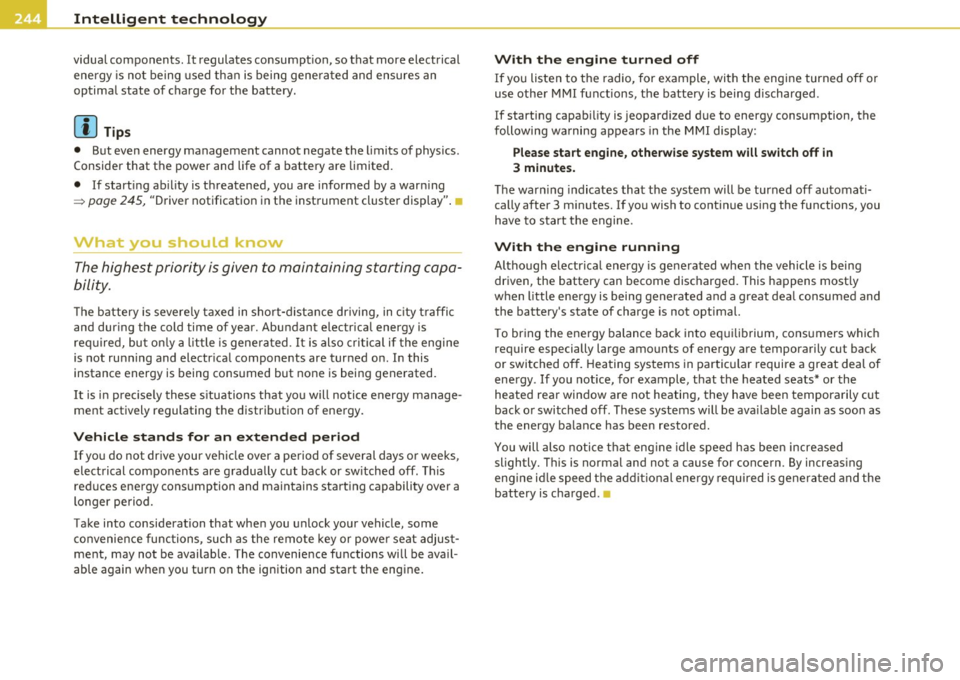
Intelligent technology
'-------------------------------------------------
vi dual components. It regulates consumption, so that more electrical
energy is not being used than is being generated and ensures an
optimal state of charge for the battery .
[I] Tips
• But even energy management cannot negate the limits of physics.
Consider that the power and life of a battery are limited.
• If starting ability is threatened, you are informed by a warning
~ page 245, "Driver notification in the instrument cluster display" .•
What you should know
The highest priority is given to maintaining starting capa
bility.
Th e battery is severe ly taxed in short-distance driving, in city traffic
and during the cold time of year. Abundant electrical energy is
required, but only a little is generated.
It is also critical if the engine
is not running and electrical components are turned on. In this
instance energy is being consumed but none is being generated.
It is in prec ise ly these sit uations that you will notice energy manage
ment actively regulating the distribution of energy.
Vehicle stands for an extended period
If you do not drive your vehicle over a period of several days or weeks,
electrical components are gradually cut back or sw itched off. This
reduces energy consumption and maintains starting capability over a
longer period.
Take into consideration that when you unlock your vehicle, some
convenience functions, such as the remo te key or power seat adjust
ment, may not be available. The convenience functions will be avail
able again when you turn on the ignition and start the engine.
W ith the engine turned off
If you listen to the radio, for example, with the engine turned off or
use other MMI functions, the battery is being discharged .
If starting capability is jeopardized due to energy consumption, the
following warning appears in the MMI display:
Please start engine, otherwise system will switch off in
3 minutes.
Th e warn ing indicates that the system will be turned off automati
cally after 3 m inutes. If you wish to continue using the functions, you
have to start the engine.
With the engine running
Although electrica l energy is generated when the vehicle is being
driven, the battery can become discharged. This happens most ly
when little energy is being generated and a great deal consumed and
the battery's state of charge is not optimal.
T o br ing the ene rgy balance back into equilibrium, consumers which
require especially large amounts of energy are temporarily cut back
or switched off. Heating systems in particular require a great deal of
energy .
If you notice, for example, that the heated seats* or the
heated rear window are not heating, they have been temporarily cut
back or switched off. These systems will be ava ilable again as soon as
the energy ba lance has been restored.
You will also notice that engine idle speed has been increased
slightly. This is normal and not a cause for concern. By increasing
eng ine id le speed the additional energy required is generated and the
battery is charged. •
Page 270 of 362
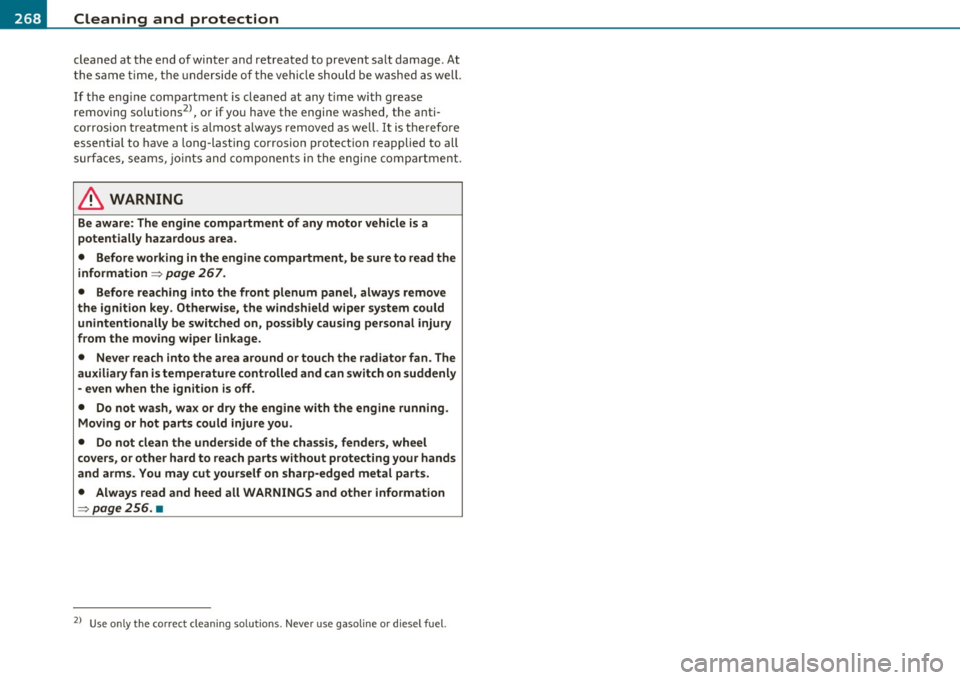
-~_C_ le_ a_n_ i_ n_ g=- a_ n_d___. p_ ro_ t_e _c_ t_ i_o _n ___________________________________________ _
cleaned at the end of winter and retreated to prevent salt damage. At
t he same time, t he un dersi de of the vehi cle s hould be w ashed as well.
If the engine com partment is clea ned at any t ime with grease
removing so lutions
2
), o r if yo u have the engine was hed, the anti
c o rros ion treatment is almost al ways removed as we ll.
It is th erefo re
e ssential to have a long-last ing corrosion p rotect ion reapplied to all
su rfac es, sea ms, joi nts and compo nent s in t he engi ne c om par tment .
& WARNING
Be aware : The engine compartment of any motor vehicle is a
potentially hazardous area .
• Before working in the engine compartment, be sure to read the
information =>
page 267.
• Before reaching into the front plenum panel, always remove
the ignition key. Otherwise, the windshield wiper system could
unintentionally be switched on, possibly causing personal injury
from the moving wiper linkage.
• Never reach into the area around or touch the radiator fan. The
auxiliary fan is temperature controlled and can switch on suddenly
- even when the ignition is off.
• Do not wash, wax or dry the engine with the engine running.
Moving or hot parts could injure you .
• Do not clean the under side of the chassis, fenders, wheel
covers, or other hard to reach parts w ithout protecting your hands
and arm s. You may cut yourself on sharp -edged metal parts.
• Always read and heed all WARNINGS and other information
=>page 256 . •
2
l Use on ly th e co rrect clean ing solut ions. Neve r use gas oline o r diese l fuel.
Page 275 of 362
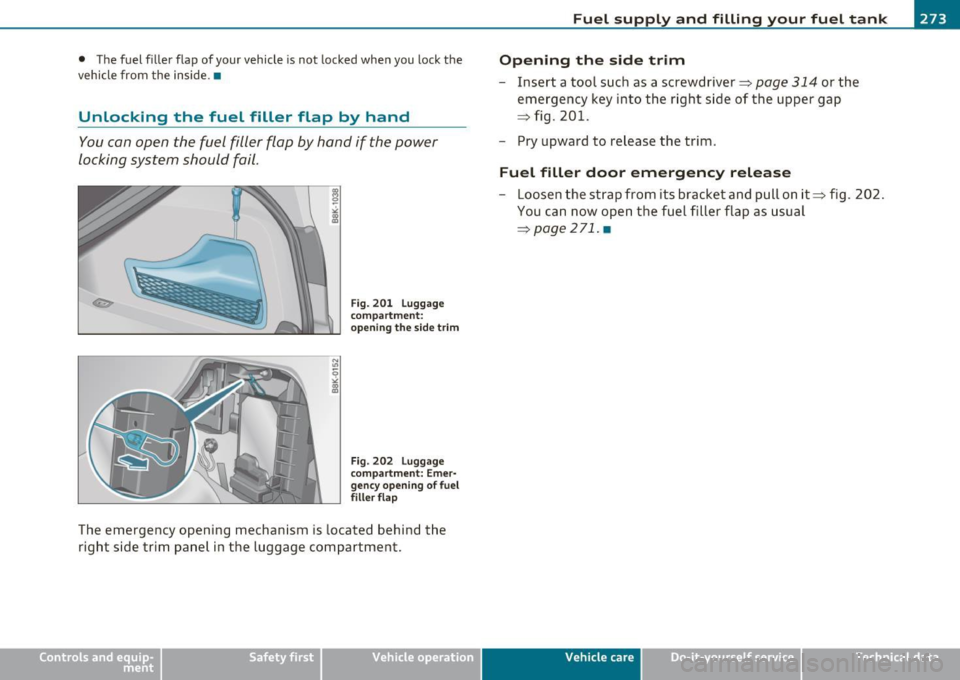
• The fuel filler flap of your vehicle is not locked when you lock the
vehicle from the inside. •
Unlocking the fuel filler flap by hand
You can open the fuel filler flap by hand if the power
locking system should fail.
N
"' 9 >< 00 a,
F ig . 201 Luggage
compar tme nt:
opening the s ide t rim
Fig. 202 Luggage
compar tment: Erner·
gency open ing of fue l
fi ller flap
The emergency opening mechanism is located behind the
right side trim panel in the luggage compartment.
Vehicle OP-eration
Fu el supp ly and filling your fuel t ank
Op ening th e side trim
- Insert a tool such as a screwdriver=> page 314 or the
emergency key into the right side of the upper gap
=> fig. 201.
- Pry upward to release the trim.
Fuel fill er door em ergency r ele ase
- Loosen the strap from its bracket and pull on it=> fig. 202.
You can now open the fuel f iller flap as usual
=:>page 271. •
Vehicle care Do-it-yourselt service iTechnical data
Page 277 of 362

Checking and filling Ill
-------------~--
Closing the engine hood
- Pull the hood down until the pressure from the struts is
reduced.
- Let the hood
drop down and latch in place. Do not try to
push it shut;
it may fail to engage=:> &.
& WARNING
A hood that is not completely latched could fly up and block your
view while driving.
• When you close the engine hood, check it to make sure the
safety catch has properly engaged. The hood should be flush with
the surrounding vehicle body parts.
• If you notice while driving that the hood is not secured prop
erly, stop at once and close it. •
Working in the engine compartment
Be especially careful whenever you work in the engine
compartment.
Whenever you must perform any work in the engine compartment,
for example checking and filling different fluids, there is a risk of injury, burns and accidents. To prevent personal injury always
observe the following WARNINGS. The engine compartment of any
vehicle is a hazardous area=>& .
& WARNING
To help avoid injury, before you check anything under the hood:
• Turn off the engine.
• Remove the ignition key.
• Apply the parking brake.
Safety first
& WARNING (continued)
• Move selector lever of automatic transmission to "P" (Park);
put manual transmission in Neutral.
• Always let the engine cool down. Hot components will burn
skin on contact.
• To reduce the risk of being burned, never open the hood if you
see or hear steam or coolant escaping from the engine compart
ment. Wait until no steam or coolant can be seen or heard before
carefully opening the hood.
• Keep children away from the engine compartment.
• Never spill fluids on hot engine components. They can cause a
fire.
• Never touch the radiator fan. The auxiliary electric fan is
temperature controlled and can switch on suddenly.
• Never open the coolant reservoir cap when the engine is still
warm. The coolant system is pressurized and hot coolant could
spray out.
• Protect your face, hands and arm from steam or hot engine
coolant by placing a thick rag over the cap when you open the
coolant reservoir.
• If work on the fuel system or the electrical system is necessary:
-Always disconnect the battery.
- Never smoke or work near heaters or open flames. Fluids in
the engine compartment could start a fire.
- Keep an approved fire extinguisher immediately available.
• To avoid electrical shock and personal injury while the engine is
running or being started, never touch:
-Ignition cables
- Other components of the high voltage electronic ignition
system.
• If you must perform a check or repair with the engine running: ..,
Vehicle care Technical data
Page 288 of 362
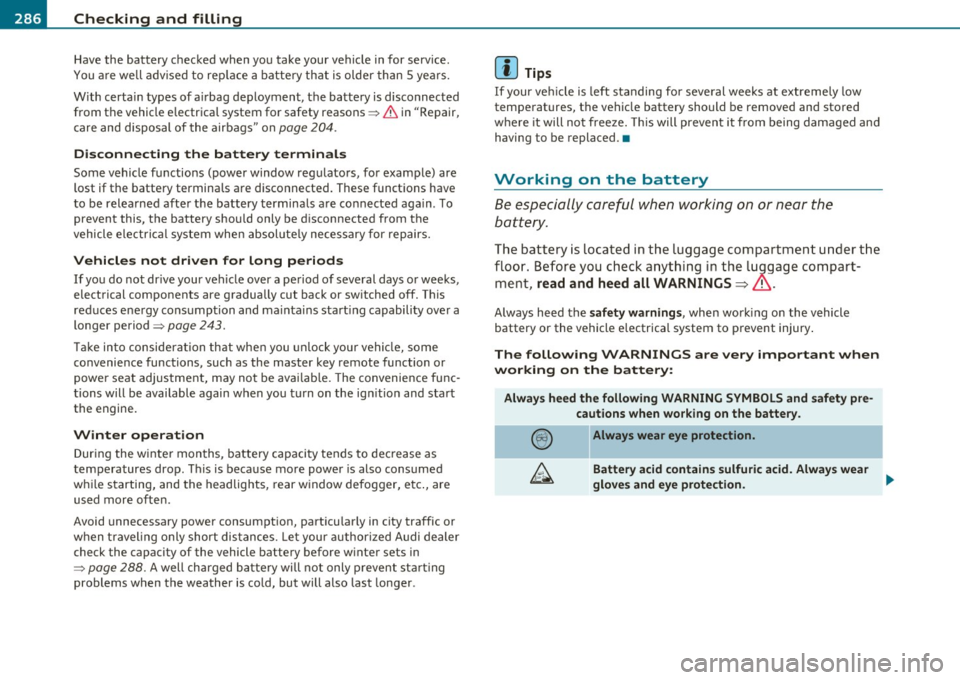
___ C_ h_ e_c _k _i _ n _g ~ a_n _d_ f_il _l_in _ g _________________________________________ _
Have the battery checked when you take your vehicle in for service.
You are well advised to replace a battery that is older than 5 years.
With certain types of a irbag deployment, the battery is disconnected
from the vehicle e lectrical system for safety reasons=>
& in "Repair,
care and disposal of the airbags" on
page 204.
Disconnecting the battery terminals
Some vehicle functions (power window regulators, for example) are
lost if the battery terminals are disconnected. These functions have
to be relearned after the battery terminals are connected aga in . To
prevent this, the battery should only be disconnected from the
vehicle electrical system when absolutely necessary for repairs.
Vehicles not driven for long periods
If you do not dr ive your vehicle over a period of several days or weeks,
electrical components are gradually cut back or switched off. This
reduces energy consumption and maintains starting capability over a
longer period=>
page 243.
Take into consideration that when you unlock you r vehicle, some
convenience functions, such as the master key remote function or
power seat adjustment, may not be available. The convenience func
tions will be available again when you turn on the ign ition and start
the engine.
W inter operation
During the w inte r months, battery capacity tends to decrease as
temperatures drop. This is because more power is also consumed
wh ile starting, and the headlights, rear window defogger, etc., are
used more often.
Avoid unnecessary power consumption, particularly in city traffic or
when traveling only short distances. Let your authorized Audi dealer
check the capacity of the vehicle battery before winter sets in
=> page 288. A well charged battery will not only prevent starting
problems when the weather is cold, but will also last longer.
W Tips
If your vehicle is left standing for several weeks at extremely low
temperatures, the vehicle battery should be removed and stored
where it will not freeze. This will prevent it from being damaged and
having to be replaced .•
Working on the battery
Be especially careful when working on or near the
battery.
The battery is located in the luggage compartment under the
floor. Before you check anyth ing in the lu~gage compart
ment,
read and heed all WARNINGS:=>& .
Always heed the safety warnings, when working on the vehicle
battery or the vehicle electrical system to prevent injury .
The following WARNINGS are very important when
working on the battery:
Always heed the following WARNING SYMBOLS and safety pre
cautions when working on the battery.
Always wear eye protection.
Battery acid contains sulfuric acid. Always wear
gloves and eye protection . .,,_
Page 338 of 362

___ G_ e_n_ e_r _a _ l_ in_ f_o _r_ m_ a_ t_io _ n _______________________________________________ _
General information
Explanation of technical data
Some of the technical data listed in this manual requires
further explanation.
The technical data for your vehicle is listed in the charts starting on
~ page 339 . This sect ion prov ides genera l information, notes and
restrictions which app ly to this data .•
Veh icle identification
The key data is given on the vehicle identification number
(VIN) plate and the vehicle data sticker.
F ig. 2 40 V ehicle I den
t ifi ca tion Nu mbe r
(V IN ) plate: locat io n
o n d river's s id e d ash
p an el Fi
g. 2 41 Th e vehicle
i d enti ficati on l abel -
in side the l ugga ge
co mpa rtme nt
The Vehicle Id ent ifi cat ion Number (VlN )
is located on the driver's s ide so that it is visible from the outside
through the windshield ~ fig . 240 . You can also d isp lay the Vehicle
Identification Number of your vehicle in the radio or in the MMI*.
Select :
I CARI function button> Veh icle ID numb er (VIN ).
The vehicle identifica tion lab el
is located in the luggage compartment near the battery .
The label~ fig . 241 shows the following vehicle data:
© Production control No.
@ Vehicle identification No.
® Type code n umber
@ Type designat io n/eng ine output in Kilow atts
© Engine and transmission code letter
© Paint No./Interior
(j) Optional equipment No.'s
Vehicle data 2 to 7 are also found in your Warranty
& Maintenance
booklet . .,,
Page 343 of 362

______________________________________________ C _o_ n _ s_u_ m_ e_r_ I_n _f_ o_ r_m _ a_t_ i_ o _ n __ _
• oil cha nges, and
• cl ea ning or re placing th e air fi lter.
W For the sake of the environment
By regu larly ma intaini ng yo ur vehicl e, y ou h elp m ake su re th at em is
sion standards a re mainta ined, t hus mi nimizing adverse effects o n
t he enviro nmen t. •
Important considerations for you and your
vehicle
Th e increas ing use of elect ronics, s ophistica ted fuel inje ct io n and
em ission cont rol systems, and t he generally increasing tec hnical
c omplex ity o f today' s automobile s, have s tea dil y re duced t he s cope
of maintena nce and repairs w hic h can be carr ied out by ve hicle
ow ners.
Also, safety and environmental c o nce rn s plac e very s trict
limits o n the nature of repa irs and adjustments to engine an d tra ns
mission parts w hich an owner can pe rform .
M ain te nance, ad justm ents and r epairs us ua lly re quir e spec ia l t ools,
test ing devices an d other e quipment availab le to s pecia lly trained
wo rksh op pe rsonnel in order to assure pro per perfor mance, re li
ability and safety of the vehicle and its many systems.
Impro per ma inte nance, adjustments and rep airs can im pa ir the ope r
ation and reliability of your ve hicle and even void your veh icle
wa rranty . Therefo re, p ro of of se rvicing in a ccordance wi th t he ma in
t enance sch edul e may be a co nd it io n fo r u phold ing a possib le
wa rranty claim made w it h in the wa rranty pe riod.
Above all, operat io nal safety ca n be adve rsely affec ted, c reat ing
unnecessary r is ks for you and your passe ngers.
If in doubt abou t any serv ic ing, have it done by your authorized Audi
dealer or a ny o ther pro perly equipped a nd qualified workshop . W e
st rong ly ur ge you to give yo ur auth oriz e d Aud i dea ler the opportu nity
t o pe rform all sc heduled mainte na nce and necessary repairs. Yo ur
Safety first
dealer has the facilities, o rigina l parts and trained spec ia lists to keep
your vehi cle runni ng properly.
Performing limited maintenance yourself
The foll ow ing page s descr ibe a lim ite d num ber of proced ures whi ch
can be perfo rmed on your vehicle w it h ordina ry tools, shou ld the need
ar ise and tr ained pe rsonnel be u navailabl e. Befo re pe rforming any of
t hese p rocedures, always t horoughly read all of the applicable text
and ca ref ull y follow the ins tru ction s given . Alw ays rigoro usly o bserve
t he
WARNINGS prov ided .
Before you check anything in the engine compartment, always read
and heed all WARNINGS=>
& and=> & in "W orking in the engine
compartment" on
page 275.
& WARNING
• Serious personal injury may occur as a result of improperly
performed maintenance, adjustments or repairs.
• Always be extremely careful when working on the vehicle.
Always follow commonly accepted safety practices and general
common sense . Never risk personal injury .
• Do not attempt any of the maintenance, checks or repairs
described on the following pages if you are not fully familiar with
these or other procedures with respect to the vehicle, or are uncer
tain how to proceed.
• Do not do any work without the proper tools and equipment .
Have the necessary work done by your authorized Audi dealer or
another properly equipped and qualified workshop .
• The engine compartment of any motor vehicle is a potentially
hazardous area. Never reach into the area around or touch the
radiator fan. It is temperature controlled and can switch on
suddenly -even when the engine is off and the ignition key has
been removed. The radiator fan switches on automatically when
the coolant reaches a certain temperature and will continue to run until the coolant temperature drops. ..
Do-it,yourself service Technical data